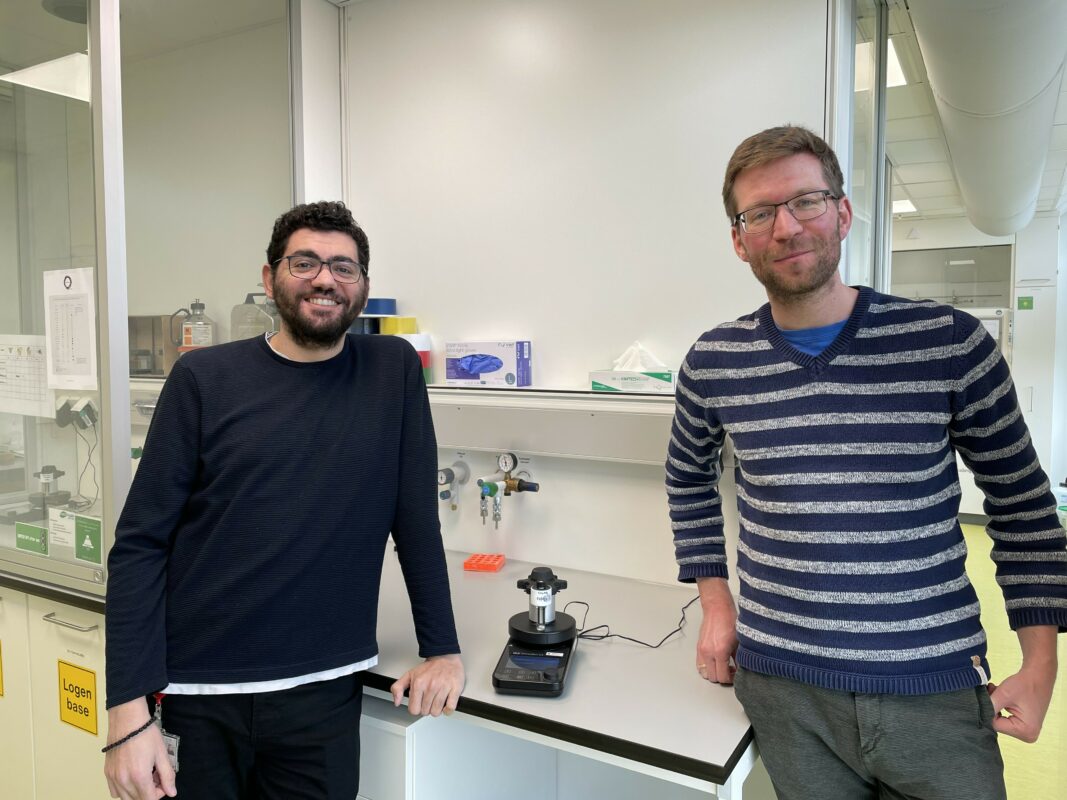
Sebastian Beil (right) and first author of the publication Marios Kidonakis running their new sugar oxidation in a small and simple instrument (black plate in between). Picture: Alexandra Matei
Today’s climate problems ask for new chemistry. Electrochemistry is such a way of chemistry, but we still need to make progress to bring it into application outside of the lab. Why does electrochemistry hold so much potential? Where can we apply it, and what progress do we still need to make? We explored these questions in an interview with Sebastian Beil, ARC CBBC assistant professor at the University of Groningen, who recently published his work in ACS Catalysis, together with the group of prof. Adri Minnaard.
Electrochemistry
In many conventional chemical processes, catalysts are used to make sure the reactions take place more quickly and easily. In this way, processes require less energy, take less time, and yield more of the desired product. Conventional catalysts are often metal-based, but there are certain downsides to these metal-based catalysts.
The reaction Sebastian studied is conventionally catalyzed with palladium catalysts. But, even though palladium catalysts are incredibly useful, they also bring some challenges. “Palladium is a very versatile metal, you can do a lot of catalysis with it. There are even some Nobel prizes awarded for palladium catalysis.”, Sebastian tells us. “However, it is not so abundant, and it can be toxic, depending on its application. So it’s important to try to get rid of it. Sometimes that is just not possible, but now we were lucky to be able to replace it.”
There are two ways in which we can use electrochemistry in our processes. We can transform existing conventional processes into ones that use electrochemistry, or we can create completely new production pathways. “You can work in a top-down way, in which you have an existing process, and you try to make it more sustainable. But you can also use a bottom-up way, in which you start building something up with electrochemistry”, Sebastian explains. “That is in my opinion the big beauty of organic chemistry. You can draw whatever is chemically plausible on paper, but that doesn’t mean that it exists in the real world. In organic chemistry, you can then go to the lab and try to find ways to make it happen.”
In his recent paper, Sebastian and his team collaborated with the Minnaard group, and used electrochemistry to do the former of these two options. They picked an existing route, one that uses palladium, and started looking for ways to make it more sustainable using electrochemistry.
From sugar to coating
Not only does the research team change existing pathways to new, more sustainable ones, they picked a process that uses sugars, a naturally available feedstock. “Sugars are very cheap, natural sources. So if you can transform such a natural feedstock into something more useful, that is another aspect in making this whole design more sustainable”, according to Sebastian.
The process they reinvented was the so-called oxidation of sugar molecules. The oxidation of sugar molecules is crucial: it prepares the molecules for connecting to one another when we try to make a coating out of them. Conventionally, this oxidation is done using palladium catalysts. However, as discussed before, there are some advantages of avoiding palladium catalysts.
Sebastian and his colleagues found that it is indeed possible to oxidize sugar molecules electrochemically. “We can get the same selectivity that we saw previously when using palladium catalysts. The big advantage, however, is that we can get rid of the palladium, or even of metal catalysts in general since our electrodes are made of graphite, which is carbon-based. In addition, we get rid of certain expensive additives. We only need small amounts of substances called ‘mediators’, which we can use over and over again,”
So what is next? “We do still use organic solvents [chemicals used to help other substances solve better], which is not desirable but was necessary for now. This is what new research focuses on now: how can we make this work in water instead? Then we can make the process even more sustainable”, Sebastian explains. There are also opportunities in, for example, different types of feedstock for the reaction: “We could also try if this reaction works on larger sugar molecules than we have tried in this study. Or we could try making a different product with a similar reaction. And we could show that this does not only work on a small scale in the lab, but also on a large scale. Because, of course, the industry is not interested in milligrams, they want kilograms, or tons eventually.”